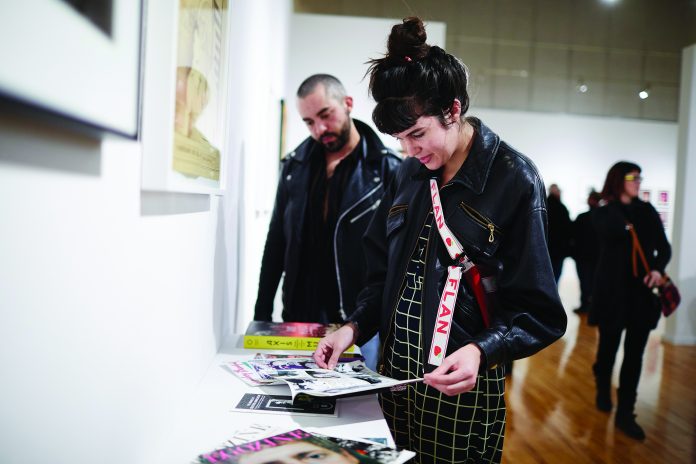
Over drinks after the opening reception of “Axis Mundo,” a colleague of mine, Anita Revilla, told Alisha Kerlin that, the show had been the first time she had seen herself in the museum in her 14 years working for the University of Nevada, Las Vegas.
On walking in hours before the opening, I myself was taken aback by the Spanish translations of English descriptions, wondering if this had been the first time a show at the UNLV Barrick Museum had intentionally had Spanish and English on their walls.
The show’s content, gay, lesbian, and otherwise queer centric, was curated from materials from the One Archive, the largest LGBT archive, based in California.
The show lasted almost two months, students and colleagues moved by the content and inspired by the historic lives of gay, lesbian and others (who we now call) queer representations in art. I rarely saw a day it was empty, constantly revisiting to absorb the emotional and historic significance of the collection.
The show documents the lives of queer performers from the 1970s through the 1990s in a way that, for students from UNLV, could better historicize their/our own queer existence in the U.S.
The art on the walls and display was a part of their/our history in ways that affirmed ongoing efforts of representation that centers our joy and our resilience.
In speaking of joy and resilience, it is not to say that the art minimized the struggles of HIV, AIDS, discrimination or political persecution. The exhibit had images referencing those struggles.
The images of those struggles, however, centered on resistance, celebration of life and educating community members of the LGBT community on where to get resources, how to have safe sex and about the everyday opportunities to disrupt gender normativity and sexual repression.
This celebration of joy, some of which was adult-themed, was followed by “Sorry for the Mess,” an exhibit featuring local Las Vegas artist, Justin Favela, and Ramiro Gomez, whose work centered on celebrating joy and documenting resilience not of their gay existence, rather of their childhood joys.
On the large wall between the two doors, the artists centered their family members, who were service workers in their regions of settlement, their artistic inspiration of the ephemeral and affective centered on the juxtaposition of centering invisible labor alongside renditions of childhood soccer fields, Sesame Street muppets and casino rugs reconstructed through pinata paper
Cardboard, strong yet temporary, serves as the primary material used throughout the exhibit, as it is the canvas on which Gomez painted, the material used to make an artificial soccer field, the giant “wet floor/piso mojado” signs throughout the museum, and the walkway on which the visitor is expected to walk. The artists juxtapose images of universal U.S. childhood like “Sesame Street” with images of family service workers at the casino, in gardens, among other areas to complicate the negative portrayal of Latino/Chicano childhood in the Southwest. The images are not apologizing for themselves, rather, “the mess” seeks to ask the viewer to consider what is messy about what may appear as unrelated images on unexpected mediums and to refl ect on their/our role in perceiving joyful yet invisible lives as messy.
These two exhibits cover diff er time periods and overlap in regional history as well as in challenging the visitor/viewer to consider how artists seek to center joy in spite of trauma, poverty, invisibility in the ways they document theirs and their communities’ daily lived realities. At the Believer Fest, and on the podcast episode Favella recorded during his panel, he explained his concern in the marginalized artist centering their trauma in their work. These two shows resist the investment, focusing instead on the joy of the lives of their subjects. The curators of Axis Mundo and the artists whose work are in the exhibit “Sorry for the Mess,” do not shy away from grief or poverty, rather they surround those images with joy, beauty, hope and resilence to defy the ways in which queer Latino artists could be remembered, in this way Erika Abad is a University of Nevada, Las Vegas assistant professor-in-residence in gender and sexuality studies in the Interdisciplinary Studies Program.





























